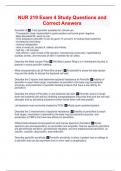NUR 219 Exam 4 Study Questions and
Correct Answers
Penicillin G ✅- First penicillin available for clinical use
- Therapeutic Uses: bactericidal to gram positive and some gram negative
- Best absorbed IM, worst is oral
- Only potassium penicillin G can be given IV (concern for kidney/heart patients)
- excreted by the kidney
- minimal metabolism
- risks in renal pts, acutely ill, elderly and infants
- half life = 30 minutes
- side effects = pain at site of IM injection, neurotoxicity (seizures), hyperkalemia
(cardiac arrest), and necrosis of skin if injected into an artery
Describe the Beta-Lactam Ring ✅The Beta-Lactam Ring is a 4 membered ring that is
present in every penicillin makeup.
What characteristics do all Penicillins share? ✅All penicillin's share the beta-lactam
ring and the ability to disrupt the bacterial cell wall.
Describe the 3 factors that determine bacterial resistance to Penicillin ✅Inability of
penicillin to reach their target, inactivation of penicillin's (the beta ring) by bacterial
enzymes, and production of penicillin binding proteins that have a low affinity for
penicillin's.
Describe the effect of Penicillin on the bacterial cell wall: ✅Penicillin works to break
down the bacterial cell wall by inhibiting transpeptidases (enzymes that give the cell wall
strength) and by activating autolysins (which break down cell wall growth).
List bacteria most commonly treated by PCN: ✅Mostly gram-positive bacteria
Describe the 3 mechanisms of bacterial resistance: ✅Inability of penicillins to reach
their target, inactivation of penicillins (the beta ring) by bacterial enzymes, and
production of PBP's that have low affinity for penicillins.
Differentiate between broad-spectrum and narrow spectrum penicillins ✅Broad-
spectrum are aminopenicillins, so amoxicillin and ampicillin. Narrow spectrum penicillins
are penicillinase-sensitive, penicillinase-resistant, and anti-staphlococcal penicillins, so
nafcillin, oxacillin, dicloxacillin, and methicillin
Describe penicillin sensitivity ✅Penicillin sensitivity is when a patient has an allergy to
a penicillin that can be anywhere from a minor rash to anaphylaxis.
, How is sensitivity diagnosed? ✅It is diagnosed by watching a patient closely if it is
there first time receiving penicillin. There could be an immediate, accelerated or even
late reaction.
How is sensitivity treated? ✅It is treated with epinephrine, respiratory support and skin
testing prevention. Consider using cephalosporin if it is a mild reaction, but avoid it all
together if it's a severe reaction
Describe the characteristics of the prototype drug: Penicillin G (Bicillin) ✅Therapeutic
use: Bactericidal to gram-positive bacteria and some gram-negative
Absorption: Best absorbed IM and gets in within 15 minutes; worst option is PO
Distribution: Well into most body fluids; without inflammation, it won't cross the blood
brain barrier, but will with inflammation
Mechanism of Excretion: Isn't changed by metabolism and is excreted by the kidney
(monitor in kidney issue patients)
Side Effects and Toxicities: Pain at site of IM injection, sensory/motor dysfunction,
neurotoxicity, hyperkalemia
Nursing Implications: Gentamycin can be given with penicillin, but not at the same time!
If pain is present at IM injection site, treat with ice; monitor patients with kidney issues.
Describe the development of MRSA: ✅Staph colonizes in nostrils and on the skin;
infection involves boils, abscesses, cellulitis, and impetigo
Differentiate between HA-MRSA and CA-MRSA related to mechanism of transmission,
risks and treatment: ✅HA affects LTC facilities, diabetics, dialysis patients, ICU
patients, and IV lines while CA affects kids, athletes, prisoners, soldiers, etc.
Describe the mechanism of action of cephalosporin medications: ✅Cephalosporin
medications work by binding to PBP's, disrupting cell wall synthesis and causing cell
lysis.
Describe the differences between classifications of cephalosporins related to bacteria
treated, effectiveness and ability to cross the blood-brain barrier. ✅First generation
and second generation only effect gram positive, while third and fourth are against
gram-negative bacteria. From 1st to 4th, there is an increase in activity against gram
negative bacteria, increased resistance to destruction, and increased ability to reach the
CSF.
Identify the pharmacokinetic properties, route of administration, adverse effects and
drug interactions associated with cephalosporins: ✅Absorbed via IV or IM, not
effective in GI tract; well distributed to body fluids, but the 1st and 2nd generation do not
cross the blood brain; eliminated by the kidney; adverse effects are bleeding caused by
reduction in prothrombin levels (warfarin patients are watched closely) and
thrombophlebitis; drug interacts badly with alcohol and anticoagulants, can be fatal if
mixed with calcium.




